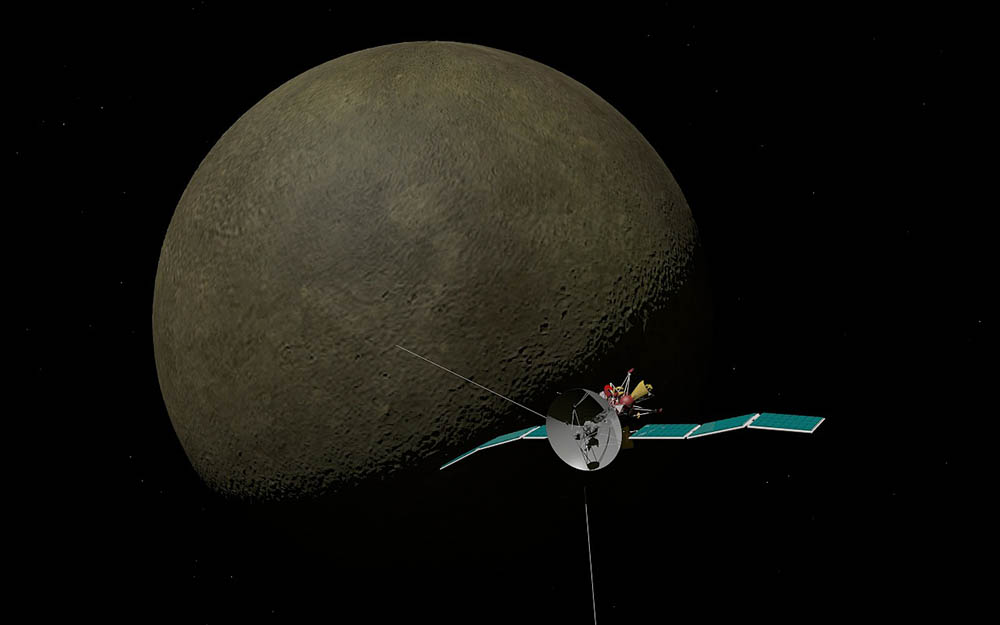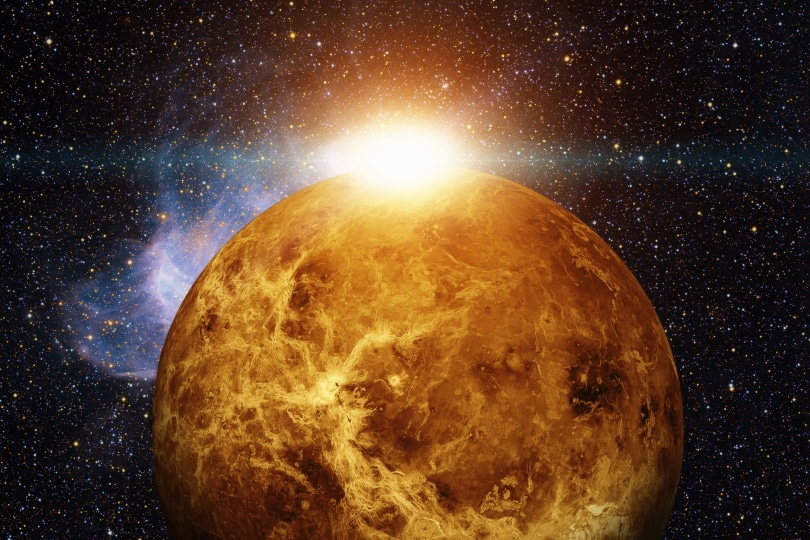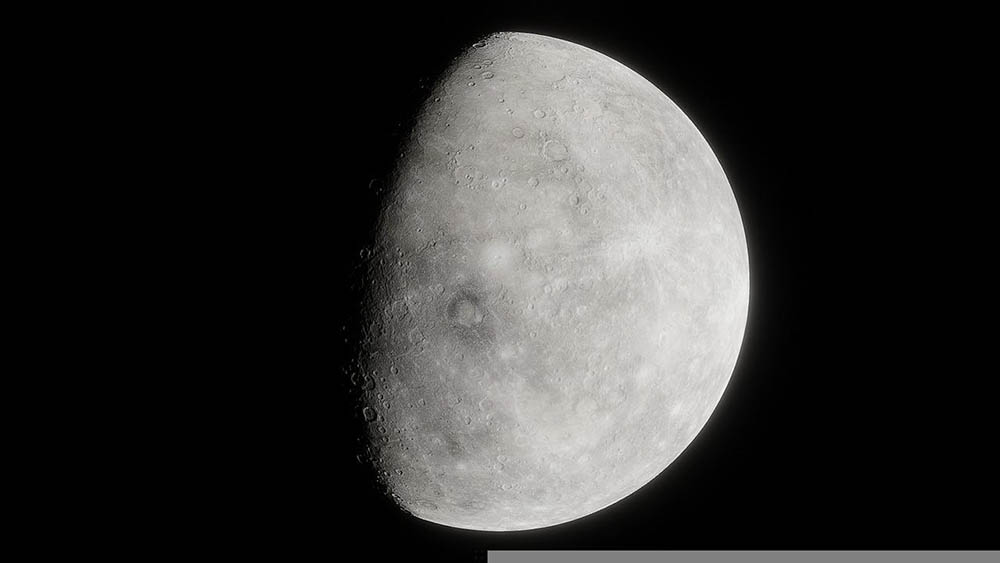How Hot is Mercury? Why Isn’t It the Hottest Planet in the Solar System?
Last Updated on

Mercury is a sweltering and extreme terrestrial planet that is not only the smallest in our solar system but also the closest planet to the Sun. This unique planet was named after the swift-footed Roman messenger god, Mercury, due to the planet blazing around the Sun at an incredible pace of nearly 30 miles per second. This allows Mercury to also set the record for the fastest planet in our solar system.
Mercury, on average, is 61% closer to the Sun than the Earth, so you could reasonably expect it to have the hottest surface temperatures. However, Mercury is beat by Venus in this competition. Although Mercury seems like a fiery inferno with an average surface temperature of 354°F, Earth’s toxic twin, Venus, averages at a balmy 847°F despite being further from the Sun.

Why is Venus Hotter Than Mercury?
Venus, also known as Earth’s evil twin, is our closest planetary neighbor and the second planet from the Sun. Although Earth and Venus have similar sizes and compositions, the two planets couldn’t be any more different. Unlike Earth, Venus is characterized by a dry, volcanic desertscape with highly-reflective clouds of sulfuric acid and a dense atmosphere that makes wading through chocolate syrup sound easy.
Venus spells death for any creature or spacecraft that dares to enter its violent domain, with surface temperatures hot enough to melt lead, hurricane-force winds, raging thunderstorms, and sulfuric acid rain. In fact, not a single spacecraft has ever survived Venus’ wrath for more than 127 minutes, as demonstrated by the Russian Venera 13 lander.
Even though Venus is further from the Sun than Mercury, it’s still significantly hotter on average. There are several reasons for this, which all boil down to each planet’s physical characteristics.

Mercury and Venus’ Atmospheres
Venus’ atmosphere is extremely dense and made of thick clouds of carbon dioxide and sulfuric acid. In fact, the atmosphere is so dense on Venus that the air pressure on its surface is 95 times that of on Earth. This is equivalent to standing at the bottom of an ocean over half a mile deep! Venus’s thick atmosphere is to blame for its fiery landscape; its gasses create a runaway greenhouse effect that traps heat from the Sun and the planet’s surface.
Because of the greenhouse effect, Venus is over 700°F hotter than it should be. Venus serves as an excellent warning for its sister planet, Earth, and is an extreme example of the consequences of carbon accelerated climate change.
Mercury’s atmosphere, on the other hand, is essentially a vacuum. The only shield it has from the expanses of space is an ultra-thin exosphere made up of atoms blasted off its surface by solar radiation, wind, and micrometeoroids. This apparent lack of an atmosphere makes it hard for Mercury to hold on to heat, as most of it is radiated into space. Additionally, Mercury is a small planet and does not have as much mass as Venus. This gives Mercury a weaker gravitational force, making it difficult for the planet to “hold on” to an atmosphere.

Mercury and Venus’ Albedos
Albedo is a term used to describe how well a surface is able to reflect sunlight and heat. Light-colored surfaces reflect a large portion of the Sun’s rays to the atmosphere, while dark-colored surfaces tend to absorb it. Albedo is rated on a scale of 0 to 1, with 0 signifying that all of the light is absorbed and 1 meaning all of it is reflected.
For example, the Moon’s albedo is about 0.12, which means that only 12% of the light that hits it gets absorbed while the rest gets reflected. Mercury has a very similar albedo at about 0.119, meaning it only reflects 11.9% of the light that hits it. On the other hand, Venus has a very high albedo at 0.90. This means it reflects nearly eight times as much light and heat as Mercury, contributing to its inferno-like temperatures.

Conclusion
In summary, the average surface temperature of Mercury is 354°F, while Venus averages at 847°F. This discrepancy is more than double that of Mercury’s temperature, despite Venus being further from the Sun. Such an extreme difference defies all reasonable expectations; however, there is a simple explanation.
Venus has an extremely thick carbon dioxide and sulfuric acid atmosphere that has taken over the planet with a runaway greenhouse effect. This has raised Venus’ temperatures to the extremes by holding onto a majority of the Sun’s heat. Mercury, on the other hand, is too small to hold onto an atmosphere and isn’t able to retain heat well.
Venus additionally reflects magnitudes more light than Mercury, with an albedo nearly eight times higher. This further contributes to Venus’ raging surface temperatures and makes it the hottest planet in our solar system, although Mercury is a close second.
Featured Image Credit By: 8385, Pixabay
About the Author Robert Sparks
Robert’s obsession with all things optical started early in life, when his optician father would bring home prototypes for Robert to play with. Nowadays, Robert is dedicated to helping others find the right optics for their needs. His hobbies include astronomy, astrophysics, and model building. Originally from Newark, NJ, he resides in Santa Fe, New Mexico, where the nighttime skies are filled with glittering stars.
Related Articles:
How to Clean a Refractor Telescope: Step-by-Step Guide
How to Clean a Telescope Eyepiece: Step-by-Step Guide
How to Clean a Rifle Scope: 8 Expert Tips
Monocular vs Telescope: Differences Explained (With Pictures)
What Is a Monocular Used For? 8 Common Functions
How to Clean a Telescope Mirror: 8 Expert Tips
Brightfield vs Phase Contrast Microscopy: The Differences Explained
SkyCamHD Drone Review: Pros, Cons, FAQ, & Verdict
